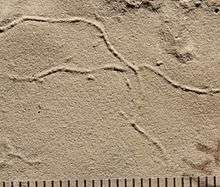Haplotichnus
Haplotichnus is an ichnogenus of invertebrate trace fossil that was erected by S.A. Miller in 1889.[1] Buatois et al. (1998) proposed that Haplotichnus should be synonymized with Gordia because both exhibit a looping course with self-crossing.[2] Other researchers, such as Wang et al. (2009), have maintained the distinction between the two ichnogenera because Haplotichnus has sharp bends, whereas those of Gordia are not sharp.[3] Most recently, Getty and Bush (2016) synonymized Haplotichnus with Treptichnus due to the presence of bifurcating projections at the bends.[4] Other features, such as the looping course of the trace, thought to distinguish Haplotichnus from Treptichnus, are actually seen in one of the syntypes of Treptichnus, further supporting Getty and Bush's (2016) synonymy.

| Haplotichnus | |
|---|---|
| Trace fossil classification | |
| Ichnogenus: | Haplotichnus |
References
- Miller, S.A. (1889). North American Geology and Paleontology for the Use of Amateurs, Students, and Scientists. Cincinnati: Western Methodist Book Concern. pp. 664.
- Buatois, L.A.; Mángano, M.G.; Maples, C.G; Lanier, W.P. (1998). "Ichnology of an Upper Carboniferous fluvio-estuarine paleovalley: The Tonganoxie sandstone, Buildex quarry, eastern Kansas, USA". Journal of Paleontology. 72: 152–180. doi:10.1017/S0022336000024094.
- Wang, Y.; Lin, J. P.; Zhao, Y. L.; Orr, P. J. (2009). "Palaeoecology of the trace fossil Gordia and its interaction with nonmineralizing taxa from the early Middle Cambrian Kaili Biota, Guizhou Province, South China". Palaeogeography, Palaeoclimatology, Palaeoecology. 277 (1–2): 141–148. Bibcode:2009PPP...277..141W. doi:10.1016/j.palaeo.2009.02.017.
- Getty, Patrick; Bush, Andrew (2017). "On the Ichnotaxonomic Status of Haplotichnus indianensis (Miller, 1889)". Ichnos. 24 (3): 234–238. doi:10.1080/10420940.2016.1270210.